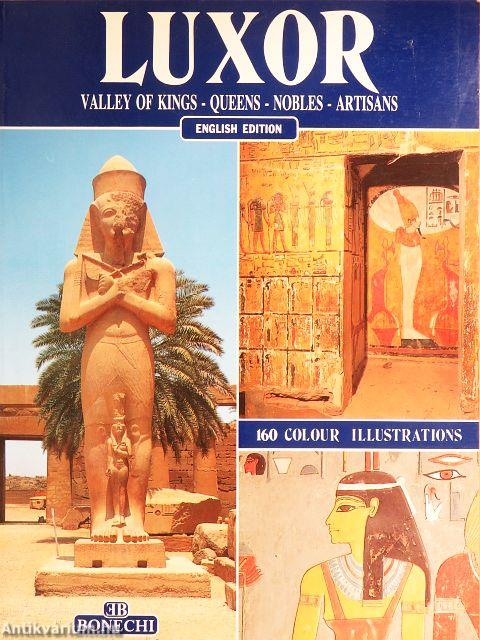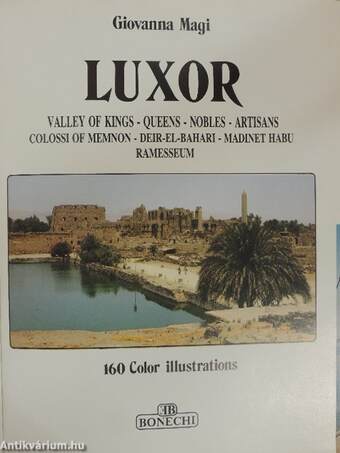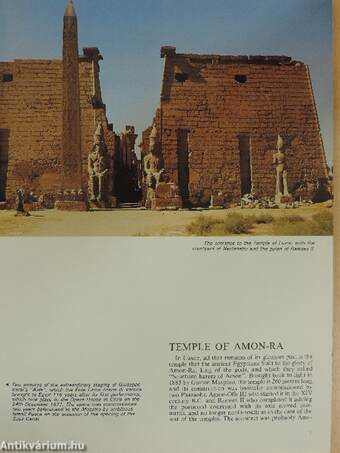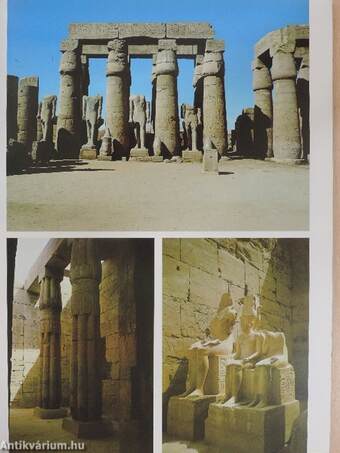1.117.662
kiadvánnyal nyújtjuk Magyarország legnagyobb antikvár könyv-kínálatát
Luxor
Valley of Kings - Queens - Nobles - Artisans - Colossi of Memnon - Deir-El-Bahari - Madinet Habu Ramesseum/160 colour illustrations
| Kiadó: | Casa Editre Bonechi |
|---|---|
| Kiadás helye: | Firenze |
| Kiadás éve: | |
| Kötés típusa: | Fűzött papírkötés |
| Oldalszám: | 93 oldal |
| Sorozatcím: | |
| Kötetszám: | |
| Nyelv: | Angol |
| Méret: | 26 cm x 20 cm |
| ISBN: | |
| Megjegyzés: | 160 színes fotóval illusztrálva. |
naponta értesítjük a beérkező friss
kiadványokról
naponta értesítjük a beérkező friss
kiadványokról
Előszó
LUXORA strip of green in the middle of the desert, tilled fields and in the background the red rocks of the "Libyan chain". Here lies Luxor, one of the great est capitals of the ancient world.... Tovább
Előszó
LUXORA strip of green in the middle of the desert, tilled fields and in the background the red rocks of the "Libyan chain". Here lies Luxor, one of the great est capitals of the ancient world. Charming and evocative, with the Nile banks lined with modern hotels, the feluccas that sail along the quiet waters of the river, the small, silent Streets of the Bazaar that come to life in the evening with their colours, sounds and lights.
This is the great, ancient city of Thebes, capital of the Egyptian empire for almost one thousand years, which Homer referred to in the IXcanto of the Iliad as "Thebes with one hundred gates" and for which "only the grains of sand in the desert surpassed the abundance of wealth contained therein". The Copts called it Tapé, hence the Greek Thebai, but for Egyptian inhabitants it was Uaset, meaning "the chief town" and Niut, "the City"; it was later on called Diospolis Magna. Its present name of Luxor comes from the Arab El Qousoür, translation of the Latin "castra" with which the ancient Romans indi-cated the city where they had installed two encampments.
In the Memphis era it was a small village where the God of War Montu was worshipped and its temples marked the boundaries of the territory. As from the X
Dynasty, thanks to its geographicalposition andpolitical grounds, its importance started to increase considerably until the military successes of its princes made it a great power. Capital of the pharaohs of the New Empire, the god Amon was worshipped in great splendour in the triad in Mut and Khonsu. It was the age of great victories and triumph in Asia Minor, Nubia and Libya. It was a happy period - perhaps the happiest in Egyptian history - and Thebes had no rivals: victorious Pharaohs accumulated incredible wealth there ("city where the houses are rich in treasure") from war booty; from the Red Sea, the Persian Gulf and even from the Sahara - across the road of the oases - merchants arrived to grow rich and to enrich the townsmen of Thebes who reached the incredible figure of half a millión!
On the east bank rise the temples in which the gods dwelt whereas on the west bünk buildings were con-structed for the worship of dead sovereigns; apart from this theory of temples, parallel to the river runs the heavy rock curtain that conceals the Valley of the Kings. Thebes then inexorably feli The very geographical position that one thousand years beforehand had favoured the birth of its power now became the main reason for its
A fe/ucca, a tourist boát sailing up the Nile and, in the background the rugged mountains of the Valley of the Kings. Vissza
Tartalom
INDEX
N.B.: in the legends of the Valleys, bold type indicates the tombs described in the text.
COLOSSI OF MEMNON
DEIR-EL-BAHARI
LUXOR
— Luxor Museum
— Temple of Amon-Ra
— Temple of Karnak
MADINET HABU
RAMESSEUM
VALLEY OF THE KINGS
— Tomb of Amon-Ofis II
— Tomb of Horemheb
— Tomb of Mineptah
— Tomb of Ramses I
— Tomb of Ramses III
— Tomb of Ramses IV
— Tomb of Ramses VI
—; Tomb of Ramses IX
— Tomb of Seti I
— Tomb of Tutankhamun
— Tomb of Thot-Mosis III
VALLEY OF THE QUEENS
— Tomb of Amon-her-Khopechef
— Tomb of Nefertari
— Tomb of Kamuast
— Tomb of Queen Thiti
VALLEY OF THE NOBLES
— Tomb of Keruef Senaa
— Tomb of Khaemat
— Tomb of Kiki
— Tomb of Menna
— Tomb of Nakht
— Tomb of Nebamon-Ipuky
— Tomb of Neferhabef
— Tomb of Rakh-Mara
— Tomb of Ramose
— Tomb of Sennefer
— Tomb of Usirat
VALLEY OF THE ARTISANS
— Tomb of Inherkha
— Tomb of Ipuy
— Tomb of Sennedjen
Page 28 70
Giovanna Magi
Giovanna Magi műveinek az Antikvarium.hu-n kapható vagy előjegyezhető listáját itt tekintheti meg: Giovanna Magi könyvek, művekMegvásárolható példányok
Nincs megvásárolható példány
A könyv összes megrendelhető példánya elfogyott. Ha kívánja, előjegyezheti a könyvet, és amint a könyv egy újabb példánya elérhető lesz, értesítjük.








